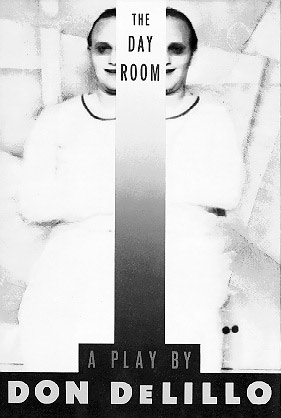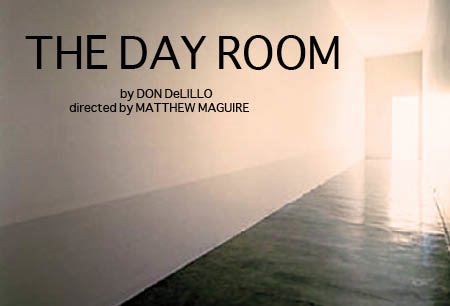
A play by Don DeLillo

"The Day Room" originally published in American
Theatre, Sept. 1986.
Published by Knopf, 1987 ($15.95) with the cover shown above,
here is the dust jacket copy.
Paperback published by Penguin in 1989 ($6.95) - see "The Day Room" editions.
No dedication.
A portion entitled "A Visit from Dr. Bazelon" printed in Harper's September, 1986.
Author's Note
This is a play about performance and concealment. It explores secret levels of language, perception and identity. Even the sets are "hidden" inside each other, and at the end of act two the motel set becomes the hospital room of act one.
When the play was first produced, at the American Repertory Theater, there were budget constraints and no time to build elaborate interlocking sets. The designer, Loy Arcenas, had an elegant solution. The desk clerk and maid clear some of the motel furniture and strip the bed, neutralizing the set; then, at a signal from Arno Klein, a silk drop is lowered from the flies. Painted on the drop is the hospital room of act one. The two-dimensional nature of the drop - its very artificiality - suggests a passage from one level of reality to another.
At the Manhattan Theater Club, about a year and a half later, director Michael Blakemore and designer Hayden Griffin were determined to make a literal transition from act two back to act one, and they did it lyrically and movingly, with Bach on the sound system and the straitjacketed figure traveling backward on his chair along a track, his face spotlighted, as rear walls parted and hospital beds emerged from collapsible sections in the side walls.
Directors and designers are encouraged to use the stage directions for this transition as a general rather than specific guide.
Don DeLillo
September 1988
Thanks to Chris Bohaska for the info on the DPS edition.

This play was first produced by the American Repertory Theater (Cambridge, MA) in April 1986, directed by Michael Bloom. A production was done in New York opening December, 1987 directed by Michael Blakemore. A story by Mervyn Rothstein on DeLillo and the production appeared in The New York Times on Dec. 20, 1987. DeLillo says:
I think theater is really mysterious and alluring for someone who has written a novel, and it seemed natural to me beginning a play that theater itself would be one of the subjects I was interested in. And I began to sense a connection, almost a metaphysical connection, between the craft of acting and the fear we all have of dying. It seemed to me that actors are a kind of model for the ways in which we hide from the knowledge we inevitably possess of our final extinction. There's a sense in which actors teach us how to hide. There's something about the necessary shift in identity which actors make in the ordinary course of their work that seems almost a guide to concealing what we know about ourselves. I think this is at the heart of the Act Two speech in which one actress addresses not only the characters on stage but the audience in the theater and says, 'We show you how to hide from what you know.'
In 1989 the play was performed by the Profile Performance Ensemble in Chicago. An article about the play entitled "A renegade's detour" by John Blades appeared in the Chicago Tribune, May 19, 1989, section 5, page 3 (contains a few DeLillo comments).
In 1993 the play was again staged in Chicago, at the Remains Theatre. Check "Creative Stages" by Sid Smith from the Chicago Tribune, May 2, 1993, section 13, pages 8, 10 (again, contains a few DeLillo comments).
Bruce Sheridan staged "The Day Room" in Auckland, New Zealand in early 1995 - here's a flyer & info from the production.

A production of "The Day Room" was staged at DeLillo's alma mater, Fordham University, in October 2009, directed by Matthew Maguire. Additional notes here on the Fordham Notes blog.